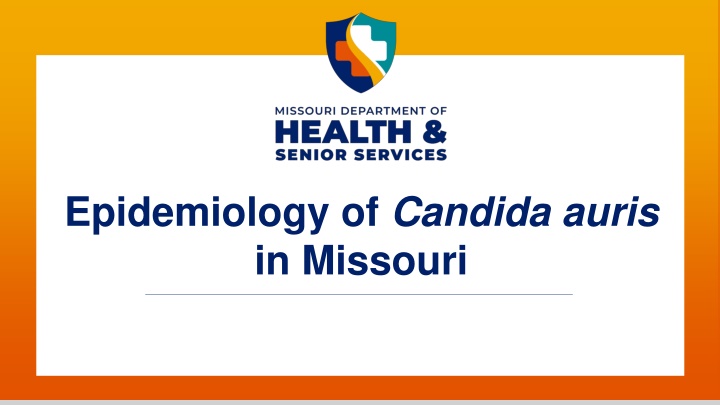
Candida Auris Epidemiology in Missouri: Cases, Transmission, and Risk Factors
Explore the epidemiology of Candida auris in Missouri, including the first detections, transmission events, patient demographics, health risk factors, and increasing identification in the Midwest. Learn about the challenges posed by this emerging pathogen in healthcare settings.
Download Presentation

Please find below an Image/Link to download the presentation.
The content on the website is provided AS IS for your information and personal use only. It may not be sold, licensed, or shared on other websites without obtaining consent from the author. If you encounter any issues during the download, it is possible that the publisher has removed the file from their server.
You are allowed to download the files provided on this website for personal or commercial use, subject to the condition that they are used lawfully. All files are the property of their respective owners.
The content on the website is provided AS IS for your information and personal use only. It may not be sold, licensed, or shared on other websites without obtaining consent from the author.
E N D
Presentation Transcript
Epidemiology of Candida auris in Missouri 6+++++
First Detection of Candida auris (C. auris) in Missouri Identified in late 2020 in an Acute Care Hospital. Patient had previous health care in Washington DC area, a known high incidence area. Screening was conducted at that time, no additional cases identified.
First Identified Missouri Transmission In October 2023, a patient in a Long-Term Care Facility tested positive on colonization screening. Patient had no history of health care outside of Missouri or known travel history. Colonization screening was conducted based on previous detection of another multi-drug resistant organism (MDRO).
C. auris in Missouri Since October 2023 there have been 8 patients identified in Missouri health care facilities. Clinical Screening 9 *23 Q4 Data as of 12/13/2023 8 7 Number of Cases 6 Case counts do not include C. auris positive patient that were identified in other states that may have received health care in Missouri 5 4 3 2 1 0 20 Q4 21 Q1 21 Q2 21 Q3 21 Q4 22 Q1 22 Q2 22 Q3 22 Q4 23 Q1 23 Q2 23 Q3 23 Q4* Year and Quarter
C. auris All 7 isolates from 6 patients that have been sequenced with Whole Genome Sequencing (WGS) have been identified as Clade IV. Positive specimens have included blood, bile, wound, and axilla/groin. Recent patients have been identified in multiple facility types including Acute Care Hospital and Long-Term Care Facilities.
Patient Demographics Patient age ranges between 36 - 83 years, median age of 67 years. 4 of 10 have known history of health care in high incidence areas. All 10 patients are identified as male. All 10 patients have history of multiple health care facilities in prior 12 months to detection. All 10 patients are considered high risk.
Patient Health Risk Factors 6 of 10 have history of invasive medical devices. 7 of 10 patients are diagnosed with diabetes. 2 of 10 patients were receiving dialysis, both with known arteriovenous fistulas. 2 of 10 have known history of another MDRO. 5 of 10 of the patient have wounds.
Transmission Increased identification of C. auris has been reported in other midwestern states, including Illinois. Currently there is no single link between the 8 recently identified cases. Transmission is suspected to have occurred between roommates in a health care facility.
HAI/AR Response Screening Screening is available to impacted facilities, even if patient is no longer at facility. Screening is done using axilla / groin swabs. Infection Control Assessment and Response (ICAR) A non-regulatory site visit designed to compare facility practices to CDC best practices with written feedback provided.
Transmission Based Precautions Enhanced Barrier Precautions Contact Precautions Gown and Glove use with every room/ patient area entry Used with positive patient Used in hospitals and dialysis centers Requires room restriction, no roommates, some facilities may restrict visitors Gown and Glove Use with High Contact activities (face covering if expecting splash) Used with Positive Patient AND High Risk Patients ONLY USED IN LTCF/SNF Does not require room restriction/ Patient is allowed to have Roommate
Environmental Cleaning Ensure all areas are being cleaned routinely, including high touch surfaces (bed rails, doorknobs, sinks, toilets, computers, etc.) with effective disinfectant. Check labels/ with manufacturers on disinfectants for kill claims and contact times. Always double check!! C. auris is somewhat limited on effective disinfectants. See EPA List P.
